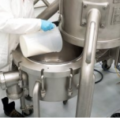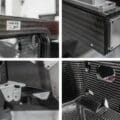Supply chain issues have affected businesses in every industry, both across the UK and globally. Widespread backlogs and shortages are crippling UK businesses, as the impact of volatile global markets continues to have an effect.
Adding more pressure to this are the labour shortages that have hit businesses across the public and private sectors, with 75% of companies struggling to hire staff according to research by the British Chambers of Commerce (BCC). The hospitality industry has been particularly badly hit, with a joint survey by UK trade bodies finding that 45% of operators have had to cut capacity and trading hours due to staff shortages, costing them £21 billion in lost revenue.
The right labour-saving and handling equipment is vital to help overcome these delays and staff shortages. Manual handling jobs are made easier and quicker to complete, therefore keeping your business running smoothly. Not only this, but under the Manual Handling Operations Regulations 1992 it is your legal obligation to minimise manual handling in the workplace where possible.
There are many different kinds and categories of handling equipment. With some insights from Dominic Slingsby, Operations Director at Slingsby, we take a look at some of the most essential, across different industries.

1. Sack Trucks
Sack trucks and platform trucks are among the most common types of hand-operated trucks, made up of a frame, platform, and wheels. They are also one of the most versatile pieces of labour-saving equipment and can be used for many different applications.
From the capacity to the style, material or even wheel type, sack trucks and platform trucks come in a variety of specifications according to the environment they are intended for and what needs transporting. Platform trucks with swivel wheels, for example, can more easily navigate tight corners in offices and school buildings, those with higher capacity ratings may find more use in industrial settings.
In Industrial settings where heavy items need moving around and there is limited space to negotiate fixed machinery or objects existing handling equipment such as fork trucks might not always be appropriate for the site conditions where the space is tight. In these cases, sack trucks or platform trucks can prove useful in allowing your staff to do more without overexerting themselves.
Foldable platform trucks, are also available for lighter duty situations in facilities or areas short on space, keeping the floor neat and clear of hazards when they’re not in use.
In 2021, 19% of all workplace accidents were related to lifting and handling, so using the right equipment is an important health and safety matter as well. This is especially true in industries that involve the manual handling of heavy items. In the construction industry, for example, there tends to be higher rates of reported musculoskeletal disorders than in any other similar industry.
Using the correct handling equipment ensures a working environment where the risk of back strain or other injuries is minimised.
2. Shelf and container trollies
In the hospitality industry, lifting and handling-related injuries are the second-most common workplace injury, so it’s important to make sure you’ve got the right equipment to minimise the physical effort of staff. Shelf and container trollies are a very efficient way of moving items to where they need to go.
Hotels and other accommodations, for instance, rely heavily on quick turnover when it comes to housekeeping. This can be even more difficult in the face of the severe staff shortages mentioned above. Making the routine processes as easy and swift as possible is of the utmost importance for the well-being of your people. Container trucks and trollies can be used to move heavier items around such as food and beverage deliveries and bed linen. Shelf trollies, meanwhile, can be used to easily move smaller items like cleaning equipment and room supplies.
The healthcare industry is another sector which can benefit from the versatility of trollies. Moving objects and equipment throughout hospitals and health centres, etc. safely and securely is paramount. This can be supported by using trollies specifically designed to transport hazardous materials or medical equipment like oxygen cylinders, consumables and documents.
3. Pallet trucks
Hand Pallet trucks or pallet jacks are another important piece of equipment where goods are primarily transported on pallets, such as in warehouses and distribution centres in the logistics industry.
They can be used by hand and with minimal effort, moving large quantities or heavy loads around different areas in a time-efficient way. Powered pallet trucks can offer an even more efficient and easier way for operators to move large loads.
4. Electric drive-powered tugs
Whatever the industry sector, if your business often moves heavy-duty loads, electric drive-powered tugs may be a better solution for increasing efficiency. Using electric batteries, these programmable tugs can push, pull, and steer wheeled loads around and are useful for moving large items up or down slopes.
Powered tugs allow for easy movement and require little physical effort from your workforce, meaning processes can be completed more quickly and thus increase productivity. Apart from saving the energy and effort of your staff, the reduction of manual handling also has the benefit of reducing the potential risk of injury.
Tugs are a higher value investment, but they are well worth it for the advantages they bring to your operations.
5. Conveyor systems
If your facility works with large quantities of items, it’s best to use equipment that is designed to move items in bulk, simultaneously. Conveyor systems are a good example of this and can be either gravity or power driven.
While both can increase labour efficiency and improve packing and dispatch times, motor-driven belts provide a greater degree of control for when items need to be moved across slopes or inclines. This also reduces the risk of injuries amongst your staff and makes the facility an overall safer workplace.
Conveyor systems are also customisable, coming in a variety of types according to what they transport and where they need to be installed. Some of these include belt conveyors, gravity roller conveyors, or flexible conveyors for a system that can adjust in size as the business needs change.
This is not an exhaustive list of handling equipment, however, the types featured here are some of the most commonly used for warehouse operations regardless of what industry you work in.
It’s never been more important to help your workforce maximise their time and energy by introducing labour-saving equipment that assists with handling and mobility. It’s also important to stress that there are many more benefits aside of improving productivity.
As both employers and employees continue to prioritise welfare, implementing the right equipment can help staff feel safer and more able to complete their tasks, leaving them feeling more valued and your facility running more efficiently.








